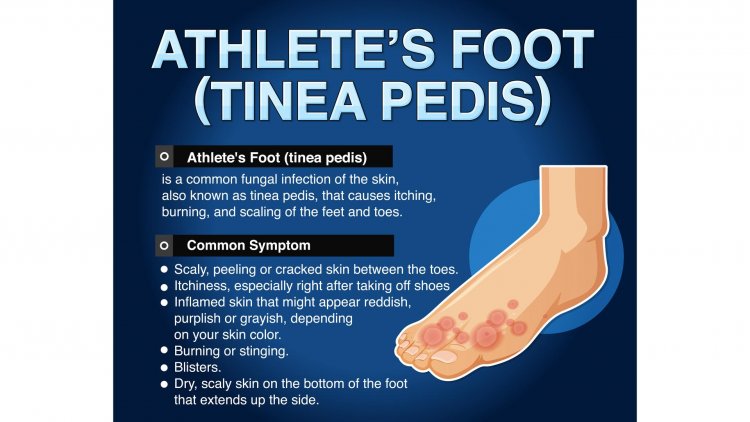Conquering Athlete’s Foot: Natural Remedies to Keep Your Feet in Top Shape
Athlete's foot, medically known as tinea pedis, is a common fungal infection that thrives in warm, damp environments. This condition, although not life-threatening, can be incredibly uncomfortable, leading to itching, burning, and peeling skin. While conventional treatments like antifungal creams and medications are commonly prescribed, many people seek natural remedies to address the problem and avoid potential side effects of pharmaceutical treatments. In this guide, we'll explore a range of natural solutions and preventative measures to keep your feet healthy and free from the pesky fungus that causes athlete’s foot.

The Roots of Athlete’s Foot: Understanding the Fungal Foe
Athlete's foot is caused by dermatophytes, a group of fungi that invade the skin's outer layer. These fungi flourish in environments that are moist and warm—think sweaty socks, damp floors in locker rooms, and communal showers. Understanding these conditions can help you take preventive steps to avoid infection.
Foot Hygiene: Your First Line of Defense
Maintaining proper foot hygiene is crucial in both preventing and treating athlete’s foot. Here are some key practices to keep in mind:
1. Keep Your Feet Dry
Fungi thrive in moist environments, so keeping your feet dry is essential. After washing your feet, make sure to dry them thoroughly, paying special attention to the spaces between your toes. Consider using a hairdryer on a low, cool setting to ensure your feet are completely dry if necessary.
2. Choose Breathable Footwear
Opt for shoes made of breathable materials like leather or mesh, which allow air circulation and reduce moisture buildup. Avoid wearing the same pair of shoes every day—give them time to dry out between wears.
3. Use Antifungal Powders or Sprays
Natural antifungal powders or sprays, such as those containing tea tree oil or baking soda, can help keep your feet dry and prevent fungal growth. Dust your feet and the insides of your shoes regularly to maintain a dry environment.
Nature’s Antifungal Arsenal: Herbal Remedies
Several natural ingredients have been shown to possess antifungal properties. Incorporating these into your daily routine can help combat and prevent athlete's foot.
1. Tea Tree Oil
Tea tree oil is a potent antifungal agent and has been used for centuries to treat various skin conditions. Its natural antiseptic properties help to kill the fungi causing athlete’s foot. To use tea tree oil:
- Dilute it: Mix a few drops of tea tree oil with a carrier oil, such as coconut oil or olive oil, to avoid skin irritation.
- Apply it: Gently rub the mixture onto the affected areas of your feet twice daily.
- Test for Sensitivity: Conduct a patch test before widespread use to ensure you don’t have a sensitivity or allergic reaction.
2. Garlic
Garlic contains allicin, a compound known for its strong antifungal and antibacterial properties. To use garlic for treating athlete’s foot:
- Create a Paste: Crush a few cloves of garlic and mix with a bit of olive oil to form a paste.
- Apply it: Spread the paste on the affected areas and leave it on for 20-30 minutes before rinsing off.
- Repeat: Apply this remedy once or twice a day until symptoms improve.
3. Apple Cider Vinegar
Apple cider vinegar is another effective natural remedy. Its acidic nature helps to create an environment that is hostile to fungal growth. To use apple cider vinegar:
- Prepare a Soak: Mix equal parts of apple cider vinegar and water in a basin.
- Soak Your Feet: Immerse your feet in the solution for 15-20 minutes.
- Dry Thoroughly: After soaking, ensure your feet are dried completely.
4. Baking Soda
Baking soda can help neutralize odors and absorb excess moisture, which is beneficial for those prone to athlete’s foot. To use baking soda:
- Create a Foot Soak: Add 3-4 tablespoons of baking soda to a basin of warm water.
- Soak: Immerse your feet in the solution for about 15-20 minutes.
- Dry: Dry your feet thoroughly after soaking.
Dietary Considerations: What You Eat Can Impact Your Feet
Your diet can also influence the health of your skin and your susceptibility to fungal infections. Incorporating certain foods and avoiding others can support your efforts to prevent and treat athlete’s foot.
1. Probiotics
Probiotics are beneficial bacteria that support a healthy gut microbiome and can influence the health of your skin. Incorporate foods like yogurt, kefir, and fermented vegetables into your diet to boost your body’s natural defenses.
2. Garlic and Onion
Both garlic and onion have antifungal properties and can be included in your diet to help combat fungal infections from the inside out.
3. Reduce Sugar Intake
High sugar levels can contribute to fungal infections by creating an environment where fungi can thrive. Reducing your intake of sugary foods and beverages can help maintain a balanced internal environment.
Protective Measures: Keeping Fungal Invaders at Bay
Taking preventive measures can significantly reduce your risk of developing athlete’s foot. Here are some additional tips:
1. Avoid Walking Barefoot in Public Areas
Public places like swimming pools, gym showers, and locker rooms are prime spots for fungal infections. Always wear flip-flops or waterproof sandals in these areas to protect your feet.
2. Use Antifungal Mats in Communal Areas
If you frequent communal areas, consider placing antifungal mats in your home or gym bag to reduce the risk of transferring fungi to your feet.
3. Regularly Disinfect Shoes and Socks
Fungi can linger in your shoes and socks, so it’s important to regularly clean and disinfect these items. Wash socks in hot water and consider using antifungal sprays on your shoes.
4. Maintain a Healthy Immune System
A strong immune system helps your body fight off infections more effectively. Ensure you get adequate rest, manage stress, and eat a balanced diet to support your immune health.
Incorporating these natural remedies and preventative measures into your daily routine can help you effectively manage and prevent athlete's foot. From proper hygiene and dietary changes to utilizing herbal treatments and protective measures, you have a range of tools at your disposal to keep your feet healthy and fungus-free.
Advanced Natural Treatments and Practical Tips for Athlete’s Foot
Continuing from our exploration of natural remedies for athlete’s foot, we’ll now delve into more advanced treatments, the use of essential oils, and practical tips for effective management. These strategies will help you enhance your fight against athlete’s foot and maintain optimal foot health.
1. Essential Oils: Potent Allies in the Battle Against Fungal Infections
Essential oils are highly concentrated plant extracts with various therapeutic properties, including antifungal effects. Several essential oils can be particularly effective against athlete’s foot:
a. Lavender Oil
Lavender oil is known for its calming and antimicrobial properties. It can soothe itchy, irritated skin and combat fungal infections. To use lavender oil:
- Dilute: Mix a few drops of lavender oil with a carrier oil such as jojoba or almond oil.
- Apply: Rub the mixture onto the affected areas of your feet twice daily.
- Patch Test: As with other essential oils, perform a patch test before use to check for any allergic reactions.
b. Eucalyptus Oil
Eucalyptus oil has potent antifungal and antiseptic properties. It can help alleviate symptoms of athlete’s foot and prevent further fungal growth. To use eucalyptus oil:
- Mix: Combine a few drops of eucalyptus oil with a carrier oil.
- Apply: Gently massage the oil blend into your feet, focusing on the affected areas.
- Avoid Contact with Eyes: Ensure you do not get the oil in your eyes as it can cause irritation.
c. Oregano Oil
Oregano oil is another powerful antifungal with a reputation for tackling tough infections. It should be used with caution due to its potency. To use oregano oil:
- Dilute: Mix oregano oil with a carrier oil, using a ratio of about 1 drop of oregano oil to 10 drops of carrier oil.
- Apply: Apply the diluted oil to the affected areas twice daily.
- Monitor for Sensitivity: Be attentive to any irritation or adverse reactions and discontinue use if necessary.
2. Natural Foot Soaks: A Relaxing Approach to Treatment
Foot soaks can be a soothing and effective way to treat athlete’s foot. They help to soften the skin, reduce itching, and combat fungal growth. Here are a few natural foot soak recipes:
a. Salt and Baking Soda Soak
Both salt and baking soda have antifungal and antimicrobial properties. To prepare this soak:
- Combine: Mix 3 tablespoons of sea salt and 3 tablespoons of baking soda in a basin of warm water.
- Soak: Soak your feet for 15-20 minutes.
- Dry: Ensure your feet are thoroughly dried after soaking.
b. Epsom Salt Soak
Epsom salt can help reduce inflammation and soothe irritated skin. To use Epsom salt:
- Prepare: Dissolve 1 cup of Epsom salt in a basin of warm water.
- Soak: Immerse your feet in the solution for 15 minutes.
- Dry: Pat your feet dry with a clean towel.
3. Dietary Supplements: Boosting Your Body’s Defense
Certain dietary supplements can enhance your body's ability to combat fungal infections and support overall foot health.
a. Vitamin E
Vitamin E is known for its skin-healing properties. It can help repair damaged skin and support the healing process. You can take vitamin E supplements or apply vitamin E oil topically.
b. Zinc
Zinc plays a role in maintaining a healthy immune system and can aid in the healing of fungal infections. Consider taking a zinc supplement or including zinc-rich foods such as nuts, seeds, and whole grains in your diet.
c. Probiotic Supplements
Probiotics can help maintain a balanced internal environment and support your body’s natural defenses against fungal infections. Taking probiotic supplements can complement your dietary efforts.
4. Footwear Maintenance: Keeping Your Shoes Fungal-Free
Proper footwear maintenance is crucial in preventing athlete’s foot. Here are some practical tips to ensure your shoes stay clean and dry:
a. Rotate Your Shoes
Avoid wearing the same pair of shoes every day. Give each pair time to dry out and air out between uses. This reduces moisture buildup and helps prevent fungal growth.
b. Disinfect Your Shoes
Regularly disinfect the insides of your shoes using antifungal sprays or powders. This helps to kill any lingering fungi and prevent reinfection.
c. Use Shoe Dryers
Shoe dryers or shoe inserts can help to remove moisture from the inside of your shoes, keeping them dry and inhospitable to fungi.
5. Fabric Care: Managing Your Socks and Linens
Your socks and linens can also harbor fungi and contribute to the spread of athlete’s foot. Here’s how to manage them effectively:
a. Wash Socks Regularly
Wash your socks in hot water with a good detergent to kill any fungi present. Avoid using fabric softeners, as they can leave residues that might create a breeding ground for fungi.
b. Use Antifungal Laundry Additives
Consider using antifungal laundry additives in your wash to ensure thorough disinfection of your socks and other fabrics.
c. Dry Socks Thoroughly
Ensure that socks are completely dry before wearing them. Moist environments are ideal for fungal growth, so keeping your socks dry is essential.
6. General Foot Care: Everyday Practices for Healthy Feet
Incorporating good foot care practices into your daily routine can help prevent athlete’s foot and maintain overall foot health:
a. Trim Your Toenails
Keep your toenails trimmed and clean to prevent fungal growth. Avoid cutting your nails too short, as this can lead to infections.
b. Avoid Sharing Personal Items
Do not share towels, shoes, or socks with others to prevent the spread of fungi. Personal items should be kept separate to reduce the risk of transmission.
c. Maintain a Healthy Lifestyle
Regular exercise, a balanced diet, and adequate hydration contribute to your overall health and support your body’s ability to fight infections.
Incorporating these advanced natural treatments and practical tips into your routine can further enhance your efforts to manage and prevent athlete’s foot. By using essential oils, maintaining proper footwear and fabric care, and following general foot care practices, you can keep your feet healthy and free from fungal infections.
Remember, while natural remedies can be highly effective, they are best used as part of a comprehensive approach that includes good hygiene and lifestyle practices. If symptoms persist or worsen, consulting with a healthcare professional is essential to ensure proper treatment and care.
Disclaimer
The information provided in this article is for educational purposes only and should not be considered medical advice. If you have any health concerns or are experiencing symptoms, it is important to consult with a healthcare professional, such as a doctor or clinic, for proper diagnosis and treatment. Always seek the advice of your doctor or other qualified health provider with any questions you may have regarding a medical condition. Do not disregard professional medical advice or delay in seeking it because of something you have read in this article.
What's Your Reaction?





















